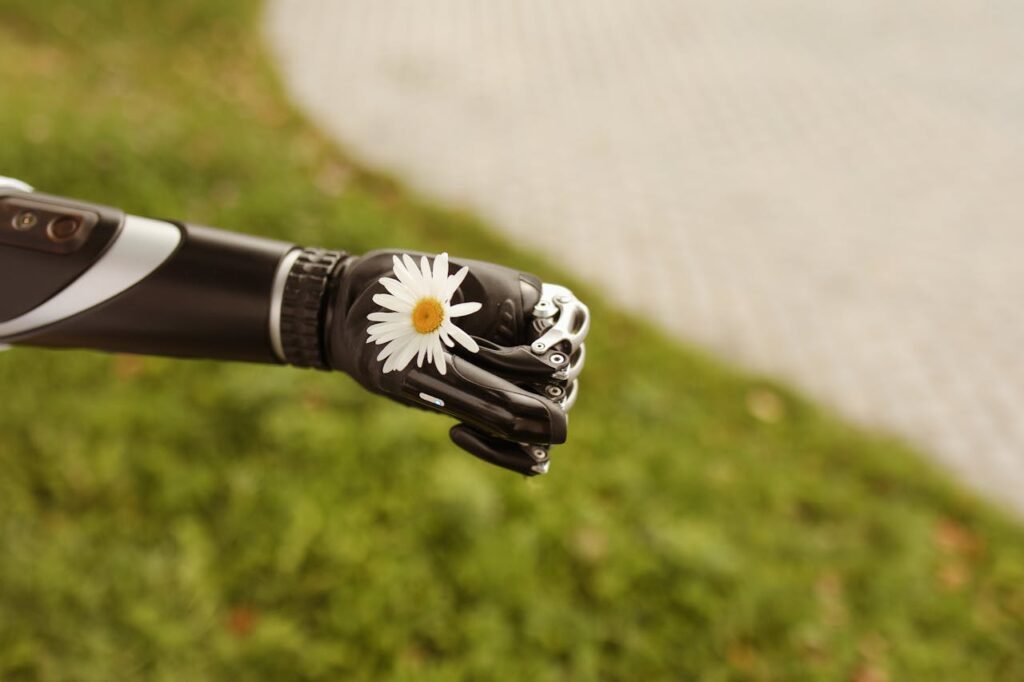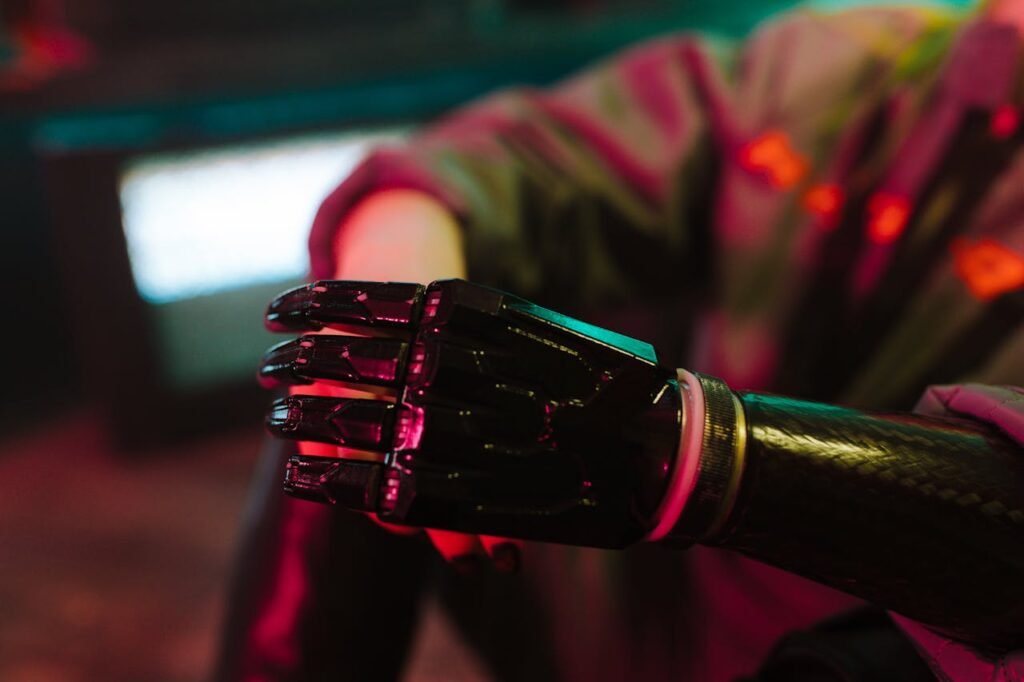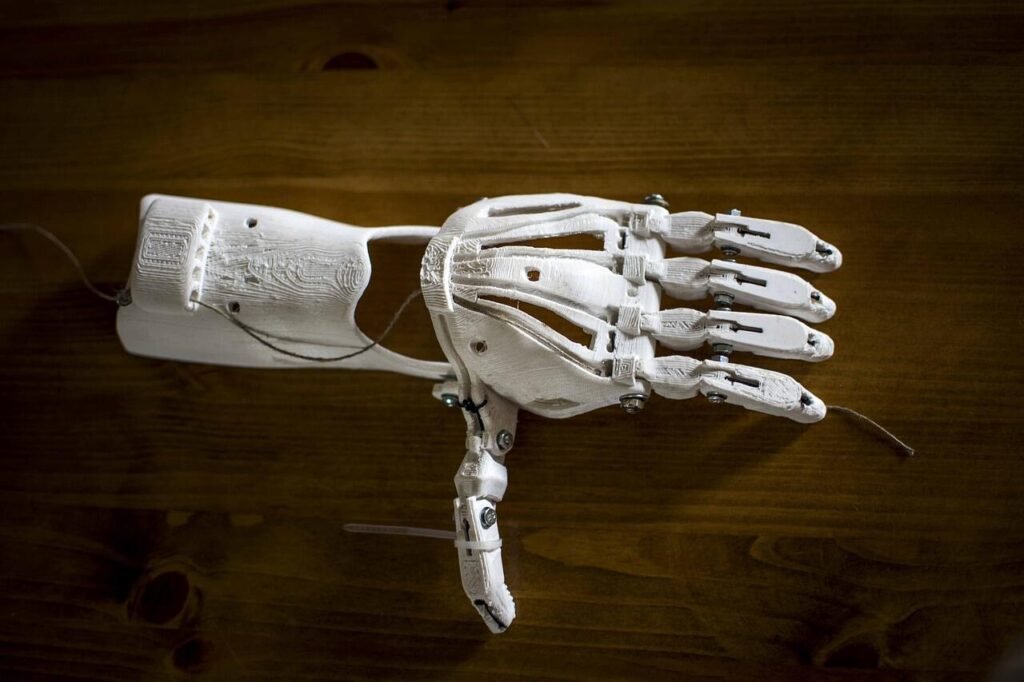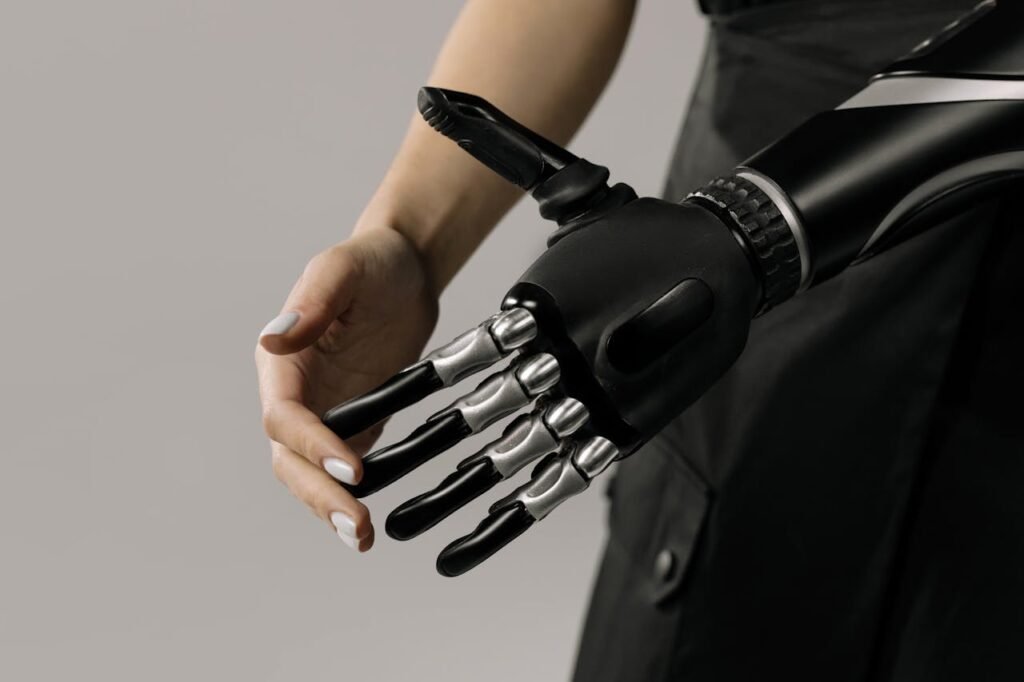When someone loses a hand or arm, they lose more than just a limb. They lose actions, independence, and sometimes, a part of who they are. But the human brain is remarkable. It never stops trying to move, to reach, to act. Even after limb loss, it keeps sending signals, hoping for a response.
That’s where bionics step in — not just to restore function, but to reconnect those signals. At Robobionics, we’ve seen this connection come alive in real people. When a user thinks about moving their fingers and their bionic hand responds, it’s more than a machine working. It’s the brain learning to speak a new language.
This article takes you on that journey — how thoughts become movement, how nerves and muscles become messengers, and how bionics become part of you. It’s not just about the tech. It’s about what your brain can do when given the right partner.
Let’s dive into how your mind learns to move machines.
The Brain Never Forgets Movement
Body Maps That Stay Even After Loss

Inside your brain, there’s a special map of your entire body. It’s not drawn with lines or labels. It’s made from billions of signals that your brain sends and receives every second. When you move your hand, scratch your head, or stretch your leg, your brain is lighting up that map.
Even when a limb is gone, the brain doesn’t erase that part of the map. It keeps it. That’s why many people still feel their hand even after amputation. They may feel it itching or moving. That ghost feeling — called phantom limb sensation — is proof that your brain still remembers your body.
This memory becomes very useful when you use a bionic hand like Grippy™. Because your brain already knows how to move a hand, it just needs to learn how to move a new one.
The hand may be made of metal and wires. But the signals? They still come from you.
How Neural Pathways Work
The Roads Inside Your Brain
Think of your brain like a big city filled with roads. Each time you move, you send a car down one of those roads. Over time, the more you use a road, the smoother and faster it becomes. That’s a neural pathway.
When you learn something new — like how to write or ride a bike — you build new roads. At first, they’re bumpy and slow. But the more you practice, the more those roads get paved. They become your go-to paths.
The same happens when you start using a bionic hand. At first, your brain doesn’t know how to send the right signals. But with time, it finds a path that works. Each successful movement smooths that path. Your brain remembers it. And eventually, it becomes automatic.
This is how thought becomes motion — through practice, feedback, and belief.
Muscle Signals Bridge the Gap
How the Brain Talks to the Bionic Hand
Your brain controls your muscles using electrical signals. These signals travel through your nerves and tell your muscles what to do. Even after an amputation, the muscles near the missing limb still get signals. They still try to respond.
Grippy™ uses sensors to pick up these muscle signals. When you think about opening your hand, the muscle in your forearm moves slightly — even if there’s no real hand there. Grippy™ reads that tiny signal and opens.
It feels like magic the first time it happens. But it’s not magic. It’s science. It’s your brain finding a way to talk again.
At first, these signals can be messy or weak. That’s normal. The brain is testing, learning, adjusting. Over time, the signals get stronger and clearer. You gain more control. The hand starts doing what you ask — not because it learned, but because you did.
Feedback Teaches the Brain
Learning by Feeling

Moving a hand is one thing. Knowing how much pressure to use is another. That’s where feedback comes in.
When you pick something up with a natural hand, you don’t crush it or drop it because your fingers are constantly sending messages back to your brain. You feel the shape, the weight, the texture. Your brain uses that feedback to adjust your grip.
Grippy™ helps bring that experience back with Sense of Touch™ — a feedback system that sends signals to your arm to show how tightly you’re gripping. It may feel like a buzz or a pulse. At first, it’s new. But soon, your brain links that feeling to the action. You grip just enough. You learn control.
This back-and-forth — signal out, feedback in — is how your brain learns best. It’s a loop. Each time you use it, the loop gets stronger. Movement becomes smoother. Mistakes become fewer.
Your brain isn’t just using the bionic hand. It’s teaching itself how to use it better.
The Role of Practice and Repetition
Strengthening the Connection
Neural pathways aren’t built in a day. They grow with use. Each time you practice a movement, your brain lays down a little more pavement on the path. Missed movements, shaky starts — they’re all part of the process.
Practice doesn’t need to be long. Just regular. A few minutes every day is enough to show your brain that this matters. Over time, your muscles respond faster. The bionic hand feels more natural. And you stop thinking so hard about every move.
That’s when the real change happens. The hand starts to feel like yours — not just something you wear, but something you trust.
How Repetition Builds Brain-Device Harmony
Practice Makes the Path Permanent
When you first start using a bionic hand, your brain is curious but uncertain. It tries sending signals, and it waits for feedback. Sometimes the hand responds well. Other times, it doesn’t. In those early days, your brain is building brand-new connections. These connections are delicate. They’re like a dirt path being used for the first time.
But with repetition — the simple act of doing something again and again — that dirt path becomes a road. Each time your brain sends a signal that works, it strengthens that connection. The more that connection is used, the easier it becomes to access. This is how automatic movement develops.
Think of brushing your teeth. You don’t plan it. You just do it. That’s the goal for bionic limb control — to reach a point where your brain sends the signal and the hand responds, with no extra thought or effort.
We’ve seen this happen with users of Grippy™. A person who once had to look at the hand while concentrating on every move slowly gains freedom. After a few weeks, they’re picking up small objects while talking to someone. Or scratching their nose without even thinking. That’s not just skill. That’s the brain and the bionic hand learning to move as one.
Feedback Creates Trust Between Brain and Bionic
Feeling Builds Confidence
When your brain sends a command and the hand responds correctly, something more than movement happens — you build trust. This trust isn’t spoken. It’s felt.
Each successful motion says, “Yes, this works.” Each time you feel the hand grip or move the way you intended, your brain relaxes. It no longer questions the process. It just acts.
But when movement feels uncertain — when you can’t tell how much pressure you’re applying or whether you’ve actually grasped something — your brain hesitates. That hesitation slows everything down. That’s why feedback systems, like Grippy’s Sense of Touch™, are so important.
They close the loop. They give your brain a reply.
With feedback, your brain gets proof: “Yes, I’m holding the cup.” Or “That’s too tight — let’s loosen up.” And when your brain gets this information, it updates its pathways. It gets better at sending signals. It fine-tunes itself.
This creates a cycle of learning. Feedback builds confidence. Confidence leads to more use. More use strengthens brain pathways. And stronger pathways lead to better control.
This cycle is at the heart of bionic learning.
Emotional Safety Supports Neural Learning
The Brain Learns Better When It Feels Safe

There’s a side to neuroplasticity that many people overlook: emotion. The brain is not just a machine that learns through data. It’s a human system that learns best when it feels safe, calm, and encouraged.
In the early days of using a bionic limb, it’s easy to get frustrated. Maybe you can’t get the hand to open. Maybe it moves too slowly. Or maybe people around you don’t understand how hard you’re trying.
These moments matter. If frustration builds, the brain tightens. It stops exploring. It stops trying. That’s why support — emotional and physical — is just as important as the technology itself.
At Robobionics, we spend time not just fitting the hand, but helping users feel heard. We talk through their challenges. We remind them that progress is slow but steady. We celebrate every win — even the tiny ones.
Because when a user feels supported, their brain stays in learning mode. It stays curious. It tries again. And with each try, a new connection is built.
This is how healing happens. Not just in the hand. But in the mind.
Adaptive Control and Brain Synchrony
Learning Together, Step by Step
Adaptive control means the hand doesn’t just do what it’s told. It learns from you. It adapts based on your input. It gets smarter over time.
This mirrors what your brain does too. So instead of just one side doing all the work, both brain and machine are changing together. They meet in the middle.
For example, if you tend to grip things with more force in the morning and more gently at night, Grippy™ can detect that. It adjusts its response to match your habits. Your brain notices this. It learns that the hand is reliable, even as your body changes.
This shared learning builds a rhythm. A natural connection.
Think of it like dancing. At first, both partners step on each other’s toes. But slowly, they learn the beat. One adjusts to the other. And soon, they’re moving as one.
That’s the goal — not just control, but harmony.
Long-Term Plasticity and Skill Expansion
The Brain Keeps Growing
Once you’ve learned to do basic movements — like opening and closing the hand — you might think the brain’s job is done. But neuroplasticity continues long after the first few weeks.
The brain doesn’t just build new connections. It strengthens them. It also builds new branches from those connections, allowing you to learn more complex tasks.
So at first, you may only be able to grip a fork. Later, you can cut food. Then, you can serve yourself. Each skill adds to the previous one. Each layer makes the brain stronger.
And as your skills grow, your identity begins to shift. You stop seeing yourself as someone recovering. You start seeing yourself as capable.
That mental shift is just as important as physical control. Because when the brain sees success, it wants to create more.
Creating Environments That Support Neural Learning
Why Context Shapes Control
When a person begins using a bionic limb, most of the focus tends to be on the technology itself — sensors, grip strength, battery life. But the real success of bionic control depends just as much on the environment where learning takes place.
For businesses in prosthetic care, rehabilitation, or assistive technology, this opens up a huge opportunity: shaping environments that support how the brain learns.
Neural pathways don’t grow in isolation. They develop best in spaces where users feel emotionally safe, physically comfortable, and consistently encouraged. This means building more than clinics. It means building neuro-friendly ecosystems.
Clinics and centers that provide structured, repeated exposure to bionic control in calming, supportive settings often see faster user progress. At Robobionics, we’ve noticed that environments that minimize stress — with natural light, quiet zones, and simple movement stations — directly influence how quickly users develop control over their bionic hand.
If you’re running a prosthetic center or planning to introduce myoelectric training, consider these design principles:
- Avoid loud, clinical lighting or noise-heavy setups.
- Use clear visual cues and simple instructions.
- Offer seated and standing positions for training, as comfort matters.
- Always reinforce small wins — the brain responds best to encouragement, not pressure.
These adjustments don’t cost much. But they make a big difference in how quickly users adapt to their new limb.
Staff Training for Brain-Compatible Coaching
People Teach People, Not Machines

While the tech gets smarter, one truth remains: people learn best from people. Your staff — clinicians, therapists, technicians — are not just fitting devices. They are guiding the brain through a complex learning journey.
Training staff in basic neuroscience-informed communication can accelerate user success and satisfaction.
At Robobionics, we’ve introduced micro-trainings on topics like:
- How to explain muscle signals in everyday language
- What to say when a user feels discouraged
- How to help users identify progress in small, subtle ways
- Using words that align with how the brain processes feedback
This isn’t about turning technicians into scientists. It’s about giving your team the emotional tools to reinforce learning. When a user hears, “That signal was stronger than yesterday,” or “You gripped that lighter this time,” they feel capable. That feeling helps their brain build trust in itself.
If you manage a prosthetic team or rehab program, make neuroscience communication part of your in-house training. It doesn’t take long, and it’s one of the most cost-effective ways to improve user outcomes.
Turn Users Into Coaches
Peer-to-Peer Learning Accelerates Growth
Something powerful happens when a new user meets someone who’s already mastered their bionic limb. There’s instant credibility. Instant belief. Suddenly, the brain sees what’s possible.
If you run a clinic, a demo center, or even a distribution hub, build a peer ambassador program. Invite past users who have succeeded with their device to come in weekly or monthly. Let them share tips, show their movement, and just talk.
It doesn’t have to be formal. Sometimes, a simple five-minute conversation can flip a switch in a new user’s brain. They stop asking, “Can I do this?” and start thinking, “I will do this.”
Robobionics has seen this strategy work across different parts of India, especially in smaller towns where access to advanced prosthetics is new. Peer modeling reduces fear, boosts confidence, and enhances learning — all while creating a stronger sense of community.
Integrate Bionic Use Into Real Life Early
Take Training Beyond the Table
One mistake many centers make is keeping bionic training inside the clinic too long. While early-stage, structured exercises are important, the brain needs real-world challenges to fully learn control.
We encourage our partners to create simple simulation spaces — a home kitchen mock-up, a desk with office tools, a grocery bag with items to sort. These are places where the user’s brain has to solve problems — and problem-solving drives faster neural development.
If you’re in charge of a rehab or training facility, here’s how to add real-life learning:
- Include daily objects like cups, notebooks, phones, and keys.
- Set small tasks like flipping a light switch or zipping a pouch.
- Ask users to narrate what they’re doing. The brain loves language-driven learning.
This form of active learning allows the adaptive bionic system to gather more nuanced data, and helps the user develop more refined control in real-world contexts.
Use Data to Personalize the Learning Curve
Let the System Learn From the User

Many bionic systems today, including Grippy™, come with analytics — usage data, signal strength readings, and movement trends. For businesses, this is more than tech info. It’s a map of how the user’s brain is interacting with the machine.
If you’re managing a clinic, distributor, or service team, build a simple data feedback loop. Every few weeks, review a user’s control data and offer insights:
- “You’re using the hand more in the morning — let’s try adding new tasks then.”
- “Your signal strength has improved by 15% — you may be ready for two-handed activities.”
- “Let’s slow down this one motion to make it smoother.”
This level of personalization makes the user feel seen. It shows them their brain is progressing, even when the wins feel small.
And from a business perspective, it turns your care model from reactive to proactive — which leads to better satisfaction, stronger retention, and more positive word-of-mouth.
Bionic Movement Is a Mental Journey
More Than Just Mechanics
Many people think using a bionic hand is about having the latest tech or strongest motors. But those who’ve walked this journey know the truth — it’s just as much about mindset as machinery.
When you move a bionic limb, you’re not just using a device. You’re inviting your brain to adapt, to try, to believe again. It’s not always easy. There are setbacks. There are days when nothing works the way it should. But with every small success, your brain rewires itself.
You grow into your movement.
At Robobionics, we’ve watched hundreds of users go through this transformation. We’ve seen the moment they first pick up a pencil again. The way their face lights up when they hold a spoon or tie a ribbon. It’s a mix of wonder, pride, and rediscovery.
That’s the real power of neural learning. It’s not just movement. It’s meaning.
Supporting the Whole Person
Beyond the Hand
Bionic care isn’t about fixing a missing part. It’s about helping someone feel whole again. That means looking beyond the limb. It means asking: How is this person thinking? Feeling? Healing?
The brain thrives when it feels supported. That’s why we work with families, clinicians, and communities — to build a circle of care that goes beyond the fitting.
When users feel safe, respected, and heard, their brains respond with openness. They try again. They learn more. They move forward, one step at a time.
This support is not a luxury. It’s a necessity. Because every new neural connection begins with a small choice: to try.
We make sure that choice feels worth it.
The Future of Bionics Is Brain-Based
Smarter Tech That Respects the Human Mind

As prosthetic technology keeps advancing, the trend is clear — systems are getting more intelligent, more intuitive, and more aligned with how the brain naturally learns.
We’re already seeing the next generation of adaptive systems that not only read muscle signals but also track movement patterns over time. They’re learning to predict intention, not just respond to it. They’re helping the brain feel more connected, more confident, and more capable.
But no matter how smart the tech becomes, one truth remains: the brain is always in charge. It’s the real source of power. And it deserves tools that understand how it learns, how it struggles, and how it grows.
That’s why we design with the brain in mind. Always.
Start the Journey With a Single Signal
You Don’t Need to Be Ready. Just Willing.
You might be wondering, “Can I really learn to control a bionic hand?” The answer is yes — not because the hand is perfect, but because your brain is.
You don’t need to know how it all works. You just need to start. One signal. One movement. One attempt.
From there, your brain will take over. It will surprise you. It will guide you. It will keep building — as long as you let it.
And we’ll be right here with you. Every signal. Every session. Every step.
Take the First Step With Robobionics
Move With Meaning
Ready to see how your brain and a bionic limb can grow together?
Schedule a free demo with us at https://www.robobionics.in/bookdemo/ and begin your journey toward independence, control, and confidence.
Grippy™ is more than a device. It’s an invitation to move again — with your brain leading the way.



